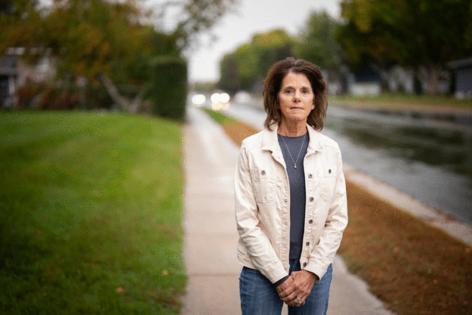Struck by an e-bike, she can no longer taste or smell. A new city ordinance in Minnesota protects pedestrians like her
Published in News & Features
MINNEAPOLIS — Janet Stotko loved baking buttery kolach breads and sweet carrot cake for her friends and family.
But since she was struck from behind by an electric bicycle, or e-bike, while walking on a sidewalk in her Hastings neighborhood over a year ago, she can no longer taste the flaky crunchy crusts of her pastries or swaths of sweet frosting spread on top. As she cooks, Stotko needs another person to taste the recipe.
“A traumatic brain injury is an invisible injury that requires a lifelong medical journey that requires ongoing care,” Stotko, 60, said. “My nerves were severed so I will never smell or taste again, ever. It’s hard to wrap your head around.”
The popularity of electric-powered bicycles has cities across the state grappling with how to protect pedestrians like Stotko and slow down the vehicles often seen zooming through parks and on trails. After hearing Stotko’s story, the Hastings City Council unanimously approved an ordinance in March that prohibited e-bike riding on sidewalks and stipulated every e-bike have a working headlight and taillight. The ordinance also lowered the speed limit for bikes on park and bike trails from 20 mph to 15 mph.
Since the ordinance went into effect, officers issue warnings to e-bikers who violate the rules, like riding on sidewalks, said Police Chief David Wilske. The department is also working with the school district to teach students the e-bike rules and also that state law prohibits those under 15 years old from riding.
“It was a horrific accident,” Wilske said. “It’s something that didn’t have to happen. I don’t think people realize these are pretty heavy bikes and they can go up to 30 mph so it really impacts people if there’s a collision.”
Because of the traumatic brain injury she sustained, Stotko cannot remember the collision.
Witnesses and first responders told her she was hit by a 14-year-old boy on an e-bike going about 25 mph. Following the crash at West 15th Street and Pleasant Drive, a neighbor provided aid before an ambulance arrived and took her to Regions Hospital in St. Paul.
“He told me ‘I thought you were dead, you were not moving,’” she said. “The boy who hit me came to (the neighbor’s) yard and said ‘I think I killed her.’”
She spent three weeks in the hospital, undergoing brain surgeries and, for a time, seeing double. She was unconscious for several days and doctors told her she was lucky to be alive.
She hopes the Legislature will pass a bill that would hold e-bike owners accountable in crashes and for more education for teen e-bike riders.
“It won’t help me but it’ll help others ... so that they don’t end up in this situation,” she said.
Under Minnesota law, there are three classes of e-bikes. A class one has pedal assist, no throttle and the assist cuts off at 20 mph. A class two e-bike has pedal assist, a throttle and the bike’s max speed is 20 mph. The third class has pedal assist, no throttle and can hit a maximum speed of 28 mph. Stotko believes she was hit by a class three e-bike.
In addition, there’s a bike sold as an e-bike, known as “e-moto” in the cycling community, which is technically illegal because it can hit speeds faster than 28 mph.
E-bike injuries tend to be more severe than regular pedal bikes because riders are going a lot faster, said Dr. Liz Placzek, pediatrician at Children’s Minnesota. E-bikes are also much heavier than standard bicycles, so those who fall off e-bikes often have multiple injuries, from broken legs and arms to head trauma.
Anecdotally, she’s seen more cases of e-bike riders coming into the hospital for severe injuries compared to the same time last year.
Placzek recommends that riders take it slow and maintain a speed under 10 mph, she said.
Determining if someone is too young to ride an e-bike — defined by law as under 15 years of age — is difficult for officers, according to various metro police departments. And e-motos, which aren’t allowed on the streets because they go over 28 mph, look so similar to e-bikes that it’s difficult for officers to discern the difference.
E-bike violations range from $95-125, according to the Minnesota Judicial Branch’s website.
Law enforcement agencies and cities have turned to social media to help educate the public on what’s allowed, in addition to installing informational signage on trails, said Jeff Potts, executive director of the Minnesota Chiefs of Police Association. Many municipalities across the Twin Cities are looking into measures beyond that to slow down speeding e-bikes and e-motos, Potts said.
“It’s a neighborhood quality-of-life issue,” he said.
In Lakeville, the City Council capped bike speeds on trails to 15 mph because the city received complaints from residents who said e-bikes were going too fast past pedestrians on trails, said Lakeville Police Chief Brad Paulson. Eagan’s police department is considering a proposal similar to Lakeville’s, said Police Chief Robert New.
In Woodbury, city officials limited what types of e-bikes can be on trails. E-bikes that can go over 20 mph are not allowed on city trails, a provision stricter than state law, according to Tom Ehrenberg, patrol commander at that city’s police department.
In Minneapolis parks, bikes are limited to 10 mph on shared trails and 20 mph on parkways, though it is not enforced much because culprits are often gone by the time park police arrive, said Robin Smothers, spokesperson for the Minneapolis Park and Recreation Board.
The board is focused on educating riders on how to ride e-bikes safely and on placing signs on trails telling bikers to slow down. On city roadways shared with cars, bikes have to adhere to speed limits. However, all shared bikes, such as Lime and Spin, are restricted to a maximum speed of 15 mph. Bicyclists cannot ride on sidewalks in downtown, uptown and the University of Minnesota campus.
It is tough for Stotko to pass by where she was hit. As she sees groups of teens zooming through the streets more than a year after her accident, she wishes they and their parents would understand the dangers the vehicles pose.
“I do still go on walks and I see the kids buzzing around on their e-bikes and I shake my head, like you have no idea,” Stotko said. “If I was a young mom or dad with a child in a stroller, there’s no way (the child) would be able to sustain the impact.”
Stotko is still going to a neurologist for her injuries that include pressure in her head, constant ringing in her ears and facial fractures. Because she cannot smell, she’s had to revamp her home with natural gas detectors and if she’s worried if food she wants to eat is spoiled, she asks someone to taste it for her.
She has yet to hear from the boy who struck her or his family following the crash.
“I try to turn the page and look forward because there’s nothing I can do about it,” she said. “I’m blessed that I’m here.”
©2025 The Minnesota Star Tribune. Visit startribune.com. Distributed by Tribune Content Agency, LLC







Comments